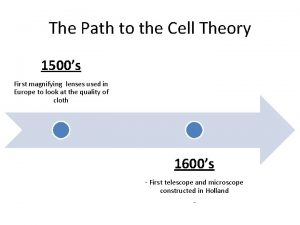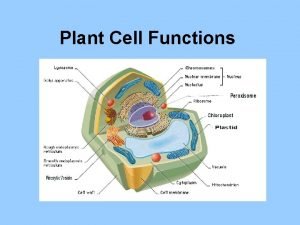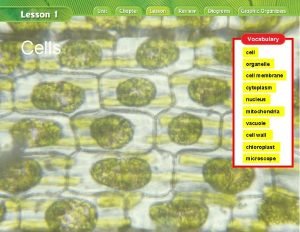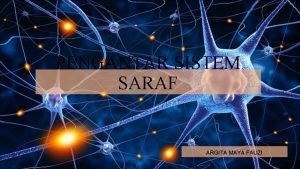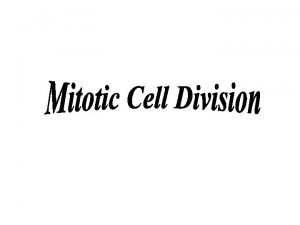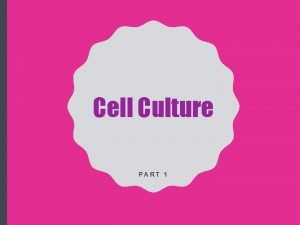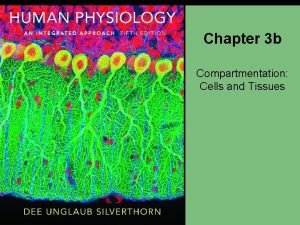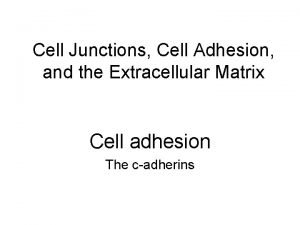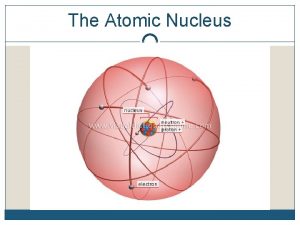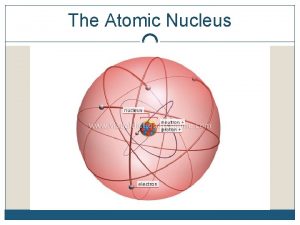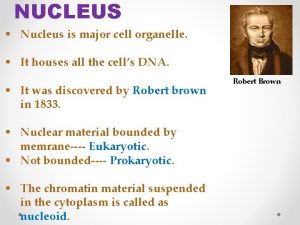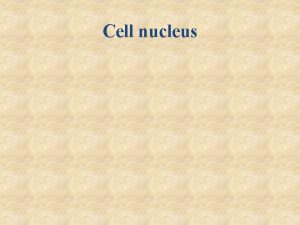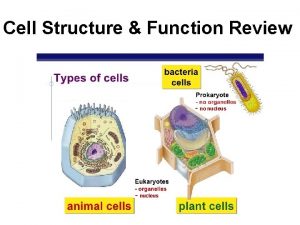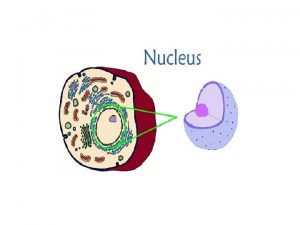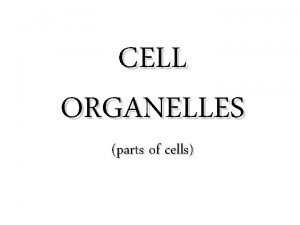The cell nucleus 932013 Definition The nucleus is




































- Slides: 36

The cell nucleus 9/3/2013

Definition : The nucleus is the most prominent organelle as compared to other cell organelles, which accounts for about 10 percent of the cell's volume. In general, an eukaryotic cell has only one nucleus. Nucleus is separated from the rest of the cell or the cytoplasm by a nuclear membrane. The nucleus is the control center of the cell. The nucleus of living cells contains the genatic material that determines the entire structure and function of that cell.


• Components of the Nucleus : 1) 2) 3) 4) Nuclear envelope Chromatin Nucleolus Nuclear matrix

v. Nuclear Envelope : Electron microscopy shows that the nucleus is surrounded by two parallel unit membranes separated by a narrow (30– 50 nm) perinuclear space or (perinuclear cisterna)


Closely associated with the inner nuclear membrane is a meshwork of fibrous proteins called the nuclear lamina or (fibrous lamina)

In non dividing cells the fibrous lamina is composed of intermediate filament proteins called lamins. three main proteins called lamins A, B, and C.

At sites where the inner and outer membranes of the nuclear envelope fuse, the resulting lipid-free spaces contain nuclear pore complexes or NPCs


nuclear pore complexes • A nuclear pore complex is made of transmembrane proteins and other proteins which form an octagonal ring, with filaments extending into both the cytoplasm and the nucleus.

Each complex contains about 30 different proteins, which have been referred to as nucleoporins.


v Chromatin : Two types of chromatin can be distinguished with both the light and electron microscopes, which reflect the degree of chromosomal condensation 1. Heterochromatin, which is electron dense, appears as coarse granules in the electron microscope and as basophilic clumps in the light microscope 2. Euchromatin is the less coiled portion of the chromosomes, visible as finely dispersed granular material in the electron microscope and as lightly stained basophilic areas in the light microscope


Chromatin is composed mainly of coiled strands of DNA bound to basic proteins called histones and to various nonhistone proteins. The basic structural unit of chromatin and histones is the nucleosome , which has a core of eight small histones (two copies each of histones H 2 A, H 2 B, H 3, and H 4), around which is wrapped DNA with about 150 base pairs. Each nucleosome also has a larger linker histone (H 1) that binds both wrapped DNA and the surface of the core.

nucleosome

nucleosome

Different levels of chromatin packing

sex chromatin • Present only in somatic cells of females but not males

Karyotyping.

v. Nucleolus : The nucleolus is a generally spherical, highly basophilic structure present in the nuclei of cells active in protein synthesis

Cell Division

mitosis

Meiosis

Meiosis

The Cell Cycle • The cell cycle has four distinct phases: mitosis, and three interphase periods termed : I. G 1 : the time gap between mitosis and DNA replication II. S : the period of DNA synthesis III. G 2 (the gap between DNA duplication and the next mitosis

The Cell Cycle

Stem Cells and Tissue Renewal • Stem cells are slowly dividing populations , Stem cells divide asymmetrically, producing one cell that remains as a stem cell and another which becomes committed to a differentiative pathway but divides a few more times at a more rapid rate. Such cells have been termed "transit amplifying cells, " each of which eventually stops dividing and becomes fully differentiated.


Apoptosis • Apoptosis is a highly regulated cellular activity that occurs rapidly and produces small membrane-enclosed apoptotic bodies, which quickly undergo phagocytosis by neighboring cells or macrophages • apoptotic cells do not rupture and release none of their contents so no inflammatory response accrue

Apoptosis

necrosis • necrosis is a result of accidental injury and rupture of cell is accrue so the release of cellular components causes a rapid series of local reactions and immigration of leukocytes in an elaborate reaction called an inflammatory response



Thank you for listening
 Definition of nucleus in a plant cell
Definition of nucleus in a plant cell Nucleus membrane
Nucleus membrane Plant cell functions
Plant cell functions Nucleus cell membrane
Nucleus cell membrane Mitochondria
Mitochondria Susunan sistem saraf
Susunan sistem saraf What is the purpose of mitosis?
What is the purpose of mitosis? Cell city analogy
Cell city analogy Difference between mercury cell and diaphragm cell
Difference between mercury cell and diaphragm cell Prokaryotic vs eukaryotic cell
Prokaryotic vs eukaryotic cell Prokaryotic and eukaryotic cells
Prokaryotic and eukaryotic cells Animal vs plant cell
Animal vs plant cell The cell reaction for the zn-h2 cell is
The cell reaction for the zn-h2 cell is Dry cell vs wet cell
Dry cell vs wet cell Plant cell and animal cell venn diagram
Plant cell and animal cell venn diagram What is the function of cell wall in plant cell
What is the function of cell wall in plant cell Plant cell and animal cell diagram
Plant cell and animal cell diagram What is the function of vacuole in the cell
What is the function of vacuole in the cell Cell wall vs cell membrane
Cell wall vs cell membrane Cell line vs cell strain
Cell line vs cell strain Finite and continuous cell lines
Finite and continuous cell lines Cell city introduction
Cell city introduction Primary voltaic cell
Primary voltaic cell Differences between plant animal and bacterial cells
Differences between plant animal and bacterial cells Cell-cell junction
Cell-cell junction Cell-cell junction
Cell-cell junction Which organelle prepares proteins for specific jobs
Which organelle prepares proteins for specific jobs Events of the cell cycle
Events of the cell cycle Life
Life Carbohydrate side chain
Carbohydrate side chain Chapter 4 cell theory and cell study
Chapter 4 cell theory and cell study Cell structures cell organelle graphic organizer
Cell structures cell organelle graphic organizer Idealized animal cell
Idealized animal cell Walker cell and hadley cell
Walker cell and hadley cell What organisms are made of eukaryotic cells
What organisms are made of eukaryotic cells Cell cycle and cell division
Cell cycle and cell division Biology.arizona.edu/cell bio/activities/cell cycle/01.html
Biology.arizona.edu/cell bio/activities/cell cycle/01.html

